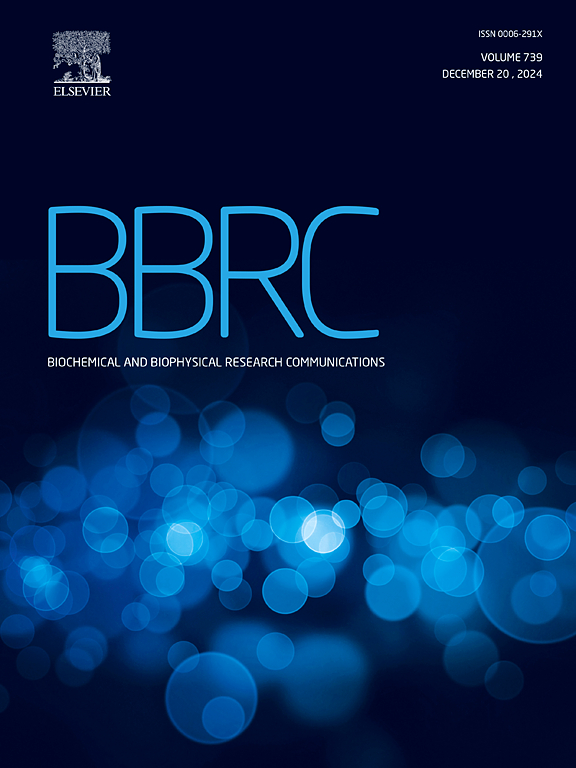Crystal structure and inhibition mechanism of AcrIIA11
IF 2.5
3区 生物学
Q3 BIOCHEMISTRY & MOLECULAR BIOLOGY
Biochemical and biophysical research communications
Pub Date : 2025-05-22
DOI:10.1016/j.bbrc.2025.152073
引用次数: 0
Abstract
Anti-CRISPR (Acr) proteins are naturally evolved inhibitors that precisely target and suppress CRISPR-Cas systems, representing a sophisticated molecular arms race between bacteriophages and their bacterial hosts. While Class 1 systems dominate among sequenced prokaryotic genomes, Class 2 systems remain primary sources of editing tools. Here, we report the structural and mechanistic characterization of AcrIIA11, an anti-CRISPR protein that simultaneously inhibits Streptococcus pyogenes (SpyCas9) and Staphylococcus aureus Cas9 (SauCas9). The 3.2 Å crystal structure reveals a compact α/β fold with distinct electropositive clefts implicated in DNA binding. While DALI analysis identified structural homology to transcriptional regulators and the RecA inhibitor PsiB (RMSD 3.3 Å), functional studies established that AcrIIA11 forms stable ternary complexes with both Cas9 orthologs and sgRNA. Biochemical assays demonstrated stronger inhibition of SauCas9 compared to SpyCas9, with EMSA revealing a critical dichotomy: AcrIIA11 maintains SauCas9-sgRNA binding to specific target DNA while completely blocking cleavage activity. Computational docking localizes AcrIIA11 at the HNH-RuvC interface without obstructing DNA-binding channels in SauCas9, suggesting allosteric inhibition through HNH domain displacement. This work establishes AcrIIA11 as a dual-purpose Cas9 inhibitor that preserves target recognition while inactivating nuclease function—a mechanism with potential applications in precision CRISPR control.
AcrIIA11的晶体结构及抑制机理
抗crispr (Acr)蛋白是自然进化的抑制剂,可以精确靶向和抑制CRISPR-Cas系统,代表了噬菌体与其细菌宿主之间复杂的分子军备竞赛。虽然1类系统在测序的原核生物基因组中占主导地位,但2类系统仍然是编辑工具的主要来源。在这里,我们报道了抗crispr蛋白AcrIIA11的结构和机制表征,该蛋白同时抑制化脓性链球菌(SpyCas9)和金黄色葡萄球菌Cas9 (SauCas9)。3.2 Å晶体结构显示出紧密的α/β折叠,具有与DNA结合有关的明显的电正间隙。DALI分析确定了其与转录调控因子和RecA抑制剂PsiB的结构同源性(RMSD 3.3 Å),功能研究确定了其与Cas9同源物和sgRNA形成稳定的三元配合物。生化实验表明,与SpyCas9相比,对SauCas9的抑制作用更强,EMSA揭示了一个关键的两分法:AcrIIA11维持了SauCas9- sgrna与特定目标DNA的结合,同时完全阻断了切割活性。计算对接将AcrIIA11定位在HNH- ruvc界面,而不会阻碍SauCas9中的dna结合通道,提示通过HNH结构域位移进行变构抑制。这项工作确定了AcrIIA11作为一种双重用途的Cas9抑制剂,它在保持靶识别的同时使核酸酶功能失活,这是一种在精确CRISPR控制中具有潜在应用的机制。
本文章由计算机程序翻译,如有差异,请以英文原文为准。
求助全文
约1分钟内获得全文
求助全文
来源期刊
CiteScore
6.10
自引率
0.00%
发文量
1400
审稿时长
14 days
期刊介绍:
Biochemical and Biophysical Research Communications is the premier international journal devoted to the very rapid dissemination of timely and significant experimental results in diverse fields of biological research. The development of the "Breakthroughs and Views" section brings the minireview format to the journal, and issues often contain collections of special interest manuscripts. BBRC is published weekly (52 issues/year).Research Areas now include: Biochemistry; biophysics; cell biology; developmental biology; immunology
; molecular biology; neurobiology; plant biology and proteomics

 求助内容:
求助内容: 应助结果提醒方式:
应助结果提醒方式:


